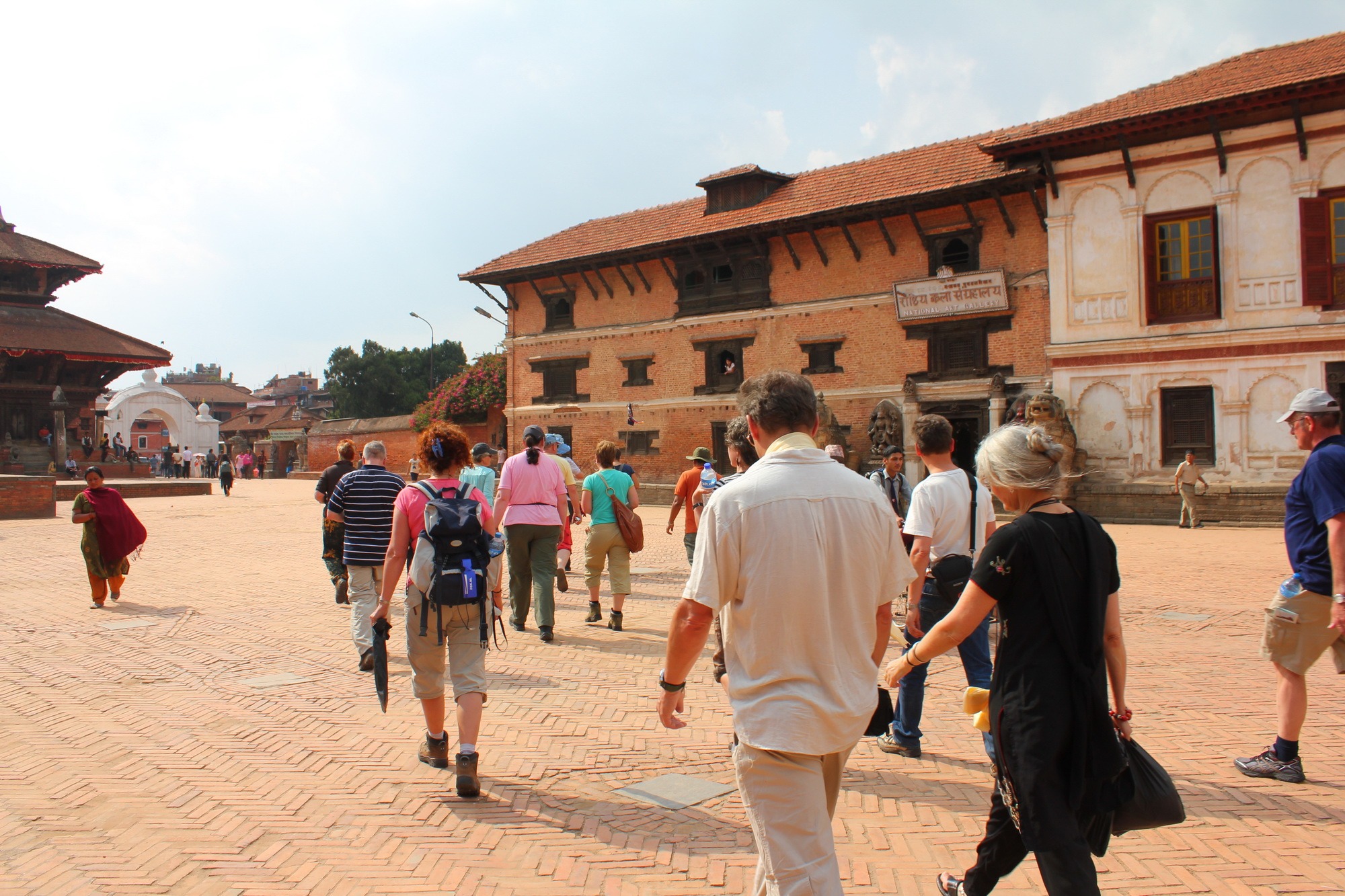

A Free Bhaktapur Walking Tour: a quick do it yourself heritage walk
On this page you’ll discover a great free walking tour of Bhaktapur, including its many famous heritage squares. The walk has two versions. A light and easy heritage walk and a more in-depth walk for heritage enthusiasts.
This page contains the light version as it’s the quickest way around while still seeing the main attractions. The in-depth version benefits from you using a dedicated guidebook on Kathmandu Valley Heritage Walks.
All links on this page are for this website only. There are no sponsored tours and not a single paid tour is mentioned. Rest easy, everything is 100% independent and honest here!
Why a free walking tour? Before getting started, let’s find out about the problems and benefits associated with walking tours in Bhaktapur. Otherwise you can jump straight to the main free walking tour here.
If you can’t find a good tour, do it yourself in Bhaktapur
Whenever I stay in Bhaktapur there is one thing that annoys me. Tour groups. I’ve watched them evolve for over a decade. My advice? Avoid them for now.
It started with untrained local guides with “attitudes” to todays expensive “new” tour guides in suits or spotless trekking trousers with a never-off smart phone in hand.

Now there’s a plethora of Chinese tour guides who like to wave a color table tennis bat at people with sticky name labels on their chests while shrieking at their group every now and then if anyone dares to wander off. All very annoying.
Then there’s the whizz through min-van tours that take in Bhaktapur, Patan, Boudhanath and Swayanbhu in a day. These package “walking tours” are usually identified by the bedazzled tourists who are rushed through at such a high pace about 85% of the sites aren’t even visited. Moreover there’s usually a speech at the end about “Sorry, there was too much traffic today to visit all the places” (that you paid for). It’s a well known ploy of tour agents which is sad as it’s also well known that that Kathmandu’s traffic is bad everyday.
The one thing they all have in common?
“Get the tourists in, get ’em out. And, repeat for maximum profit.
It’s a shame really. For Bhaktapur in particular as there’s so much to see and do in this pleasant former royal capital. Bhaktapur has refused funding from a German bank and the national government for heritage reconstruction and is instead using all the money from entrance tickets to rebuild. There’s even a temple inside Bhaktapur that you can personally donate to.
The result is that Bhaktapur remains in control of it’s own traditional reconstruction and does not have to bow down to the rules and regulations “donors” insist on.
Example of how a bad day tour generally shows you around Bhaktapur
Most tour groups arrive at Bhaktapur’s main entrance then make a big fuss over getting tickets. Take the group off around Bhaktapur Durbar Square, into the museum, around one backstreet and if you are lucky down to Potters Square or Taumadhi square … the rest of Bhaktapur is usually “too far to walk” because “you’ve run out of time”.
If you are on a half-day tour to Bhaktapur alone then you might get looking and the guide will take you to Dattatreya square and an expensive restaurant (commission).
It’s a typical scenario played over and over. Again, there’s a very simple solution. It just takes a little trust and bravery on your part. You’ll also save a lot of money, take home more information than anyone else and enjoy yourself more!
How to visit Bhaktapur by yourself and make the most out it
Firstly, it’s important to realize that Bhaktapur is a city – an ancient city at that- and not just a single Durbar (Royal) square like many tour agents make out. It’s like I’m on repeat mode here. But as always, don’t bother with the international tours you can book online. They are seriously overpriced and for the culture lovers out there they are very, very bad at describing monuments and temples.
The main reason for this is the big tour groups in Kathmandu don’t take “Newari” heritage into account.
If you really want to hire a local guide, hire one by the main Bhaktapur Durbar Square Ticket office instead of Kathmandu. These guides are genuinely local. They know the place better than anyone from a tour or travel agency in Kathmandu.
In late 2018 I was on hand to help them with up to date training. You’ll notice these guides as they have a wine or purple colored polo shirt. Sadly keeping such standards is not a priority in Nepal. Local unofficial guides still pop up and annoy you in Durbar Square if they see you without a guide or book.
The only reason to book a Bhaktapur tour online is if you want to be shuttled around or don’t really care for learning about heritage nor Bhaktapur and this ancient former royal Newari capital and just want some nice photos. If this is the case, book a Nepal tour online, sit back, let everyone do everything for you, enjoy the name sticker and the whole “been there, done that” bucket list.

You could of course open up the internet and try to research a self-guided tour of Bhaktapur yourself. Here’s a tip. Do exercise some caution. Many online blogs have simply copied content from guidebooks, taken sponsored tours, listened to under-qualified tour guides or simply don’t fully understand Nepal. A prime example are the ones that seem to constantly mix up Bhaktapur’s different squares and Bhaktapur Royal Newar heritage. Other more prominent sites are confusing and simply outdated.
Today’s online world is full of people that like to copy and paste other peoples work without credit nor fact checking it – do be careful and get your information from a trusted source.
On the other hand if you want to really want to make the most of your time in Nepal or want learn about Bhaktapur, the old squares, monuments, temples and ancient heritage you have a few better options available.
How to get the most out of a trip to Bhaktapur:
- Get a guidebook that describes everything you need, preferably with heritage walks
- Go by bus (budget -45 mins) or go by taxi or private care (30 mins) – even with return fares they are cheaper than any tour
- Dedicate a half day to Bhaktapur if you don’t like temples too much or a full day plus an overnight stay if you like them
- If Kathmandu city has too much traffic, hustle and bustle for your liking then consider staying for a few nights in Bhaktapur instead – yes there are plenty of hotels with many offering “boutique status” e.g., you’ll likely be staying in a renovated Newari heritage house. There are also plenty of budget ones just about hanging on
- If you must hire a guide, hire a local guide- despite “some” guidebooks stating they are all fully qualified guides the truth is the vast majority haven’t had a scrap of training for 10+ years. In late 2018 there was an official training program and the newly trained guides wear wine colored polo shirts.
Practical Tip: For your free Bhaktapur walking tour, start early in the morning to avoid potential crowds, especially around Durbar Square. Wear loose, comfortable travel clothes—nothing too revealing, as this is a cultural heritage site. Check current ticket prices here, which vary by season.
Finally, if you only have a half day and take one of those “tours” that promise you Patan, Boudha and Pashupatinath all in one day … then do be prepared to miss out on at least 80% of all these sites just to say you stopped by. It would be far better to do a half day in Bhaktapur and finish up in Boudha for the evening than rush around “trying” to see everything in one day.

It’s an age old travel secret – Savor one place rather than try to visit everything
And for all those friends who went and saw “everything”? Well, you can always show them a photo of the “secret” ancient temple or inscription that they never had the time to visit. Or maybe that photo of you with the real Newar musicians who play music every night inside a temple. Bhaktapur at 6am is like going back in time with ancient markets, food stalls and temple blessings taking place. Yes, looking back on your photos you’ll have the upper hand.
These are the priceless memories that no paid tour can deliver!
Now, let’s get to your free walking tour of Bhaktapur!
Free Bhaktapur Walking Tour Overview
Time needed:
- Light version (this page): 2 hours
- Heritage enthusiast: overnight stays or at least one full day
This walk can take between 2 hours or as mentioned above you could easily spread it out into an overnight stay depending on your likes.
Distance:
- Light version: (this page) – 2.6 km
- Heritage enthusiast: 4.22 km
If you do the entire heritage tour walk in my book then it’s about 4.22 km to cover or just 1.5 km if you do the main four areas.
Sites visited:
- Light version (this page): 30
- Heritage enthusiast: 70+
Bhaktapur has three main squares, one pottery square & many heritage areas
Tourism has a way of renaming places for gimmicky reasons. In Bhaktapur there are three royal courtyards that spanned several centuries. Despite the assumptions, the oldest is not Bhaktapur Durbar Square! Here’s a synopsis of all:
- Bhaktapur Durbar Square: The cities main royal courtyard – a wide open area with several temples and a museum
- Taumadhi Square: Home of Nepal’s tallest temple, some hidden gems and a dancing court
- Golmadhi Tol: An often walked area that few people stop at (dedicated walk found only in my book)
- Dattatreya Square: Bhaktapur’s oldest square that is still an embodiment of living heritage today
- Wakupati Narayan: The far east of Bhaktapur holds many temples and local heritage easily covered in a few minutes
- Pottery Square: A small square with some old kilns used to dry out pottery today
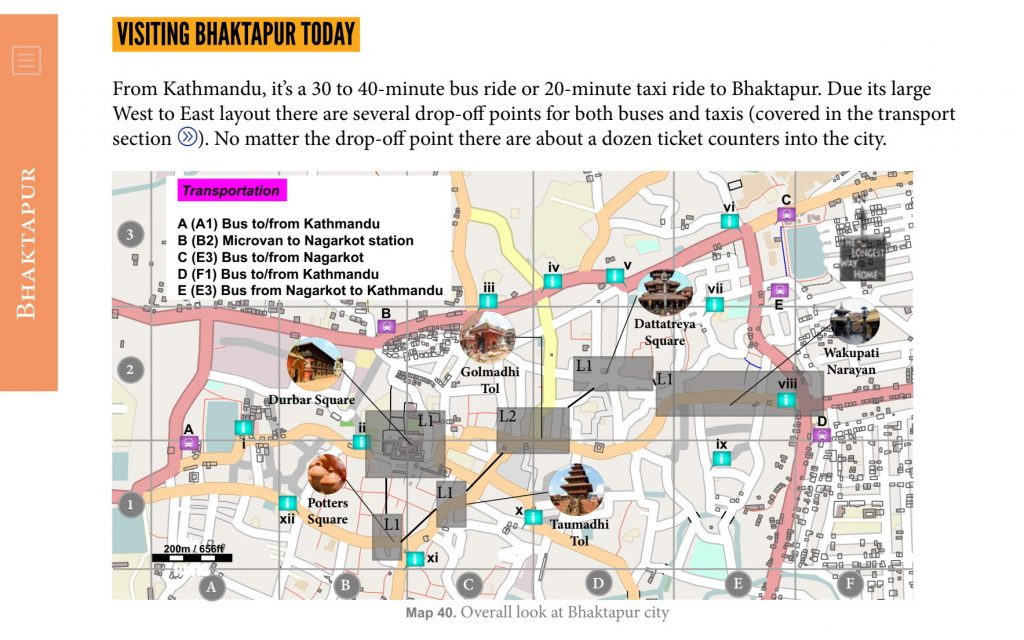
Each of the links above offer my free online guides right here to each square in Bhaktapur – you can use this page to garner a quick insight into how to walk through Bhaktapur and plan out what to see and whether you want to learn more about the place or simply find out where to get the best souvenirs from.
Let’s take a look at where to start the walk from and how to get there.
Arriving at Bhaktapur Durbar Square
Do understand that Bhaktapur city is large and not just one or four squares. There are many ways to enter it. However, and thankfully, most buses and taxis arrive at Bhaktapur’s main bus stop near a big pond by the gates to the north west. It’s about a 3 minute walk to the main Bhaktapur gates where the ticket office is. Taxis from Kathmandu will also often drop you by these main gates where the ticket office is.
Before even getting to the ticket counter, walk back about 100 feet and there’s a small rather famous shrine with erotic wood carvings. It depicts several animals in somewhat intimate “human” positions. Commonly referred to as the erotic elephant temple there are actually two temples here known as Anantalingeswar and Uma Maheshwar.
Buy your ticket at the main ticket counter. Of all places to avoid paying for a ticket, Bhaktapur should not be one. The locals have done an exceptional job in turning the fees from tickets into restoration and maintenance of heritage without much support from anywhere else. The current price for Bhaktapur is found here.
Walking around Bhaktapur Durbar Square
Again, this is just a synopsis. For a full look at the square do read my online travel guide to Bhaktapur Durbar Square.
To the right as you enter the square are two recently renovated temples. The Rameshwar Temple, dedicated to Shiva. The other in the far corner is Badrenath Temple, guarded by two small lions and it’s dedicated to Vishnu and Narayan. The huge temple in front of them is Bansi Narayan dedicated to Balaram, Subhadra and Krishna.
To your left are several interesting stone carvings in a place known as Basantapur Chowk. The one dedicated to Bhairab is so great the King had the artists hand removed so it could never be replicated! (read about the story of the artist who had his hands chopped off carving these statues).
A little further to the left is the National Art Museum. It’s one of the best Museums in Nepal but requires a separate ticket. The good news is this ticket also allows you access to two other museums later on.

A little further is the Golden Gate or Sundoka. It’s said to be Nepal’s greatest art treasure. In reality, it’s a golden gate leading into another part of the royal palace. Ignore the angry looking army guys guarding it and walk on through.
Wind your way through the short alley and you’ll spot the Taleju temple entrance to Mul Chowk on your left. Now, if you are not Hindu, Nepali or Newari, you can’t go in. The guards will ask for some verbal ID in Hindi. For everyone else you can just look from the entrance way and NOT take photos.
If you are feeling hard done by then fear not. Most people don’t visit the wonderful Naga Pokhari or Royal Bath to the rear of this courtyard. Go on through the doorway to see the impressive stone bath behind it. If you’ve ever seen the movie Little Buddha you’ll recognize this place. And yes, you can walk down the steps to the main pond area.
Come back out and take a left, we’ll come to the impressive bell and columns to the right in a while. To your left is the wondrous 55 Window Royal Palace. Yes, there are 55 windows, the little slats count as windows just in case you start to count. Inside visitation is not allowed.
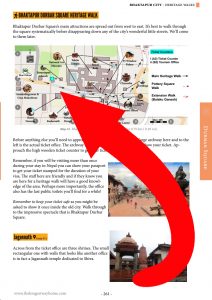
Continue straight! To your left is past a small shrine is the reconstruction of the Siddhi Laxmi temple. It was damaged in 2015 and the rebuild was completed in 2019. A little further ahead are two stone lions guarding what used to be another temple behind them long gone and forgotten by most but to us it is Harishankhana.
To the left of them is a large platform with a “Pumpkin” temple (Fasidega) destroyed again in the earthquake. Interestingly it was nicknamed this as it was rebuilt after the 1934 earthquake in rushed manner. Today they will be rebuilt using imagery from old oil paintings!
Come back around and you’ll spot an octagonal wooden pavilion known as Chyasalin. Again, many guidebooks get this one wrong too. It’s not a temple but a Pavilion. Built for the Malla kings to view dances and poetry contests from. It was rebuilt in the 1990s using steel reinforcements to make it earthquake proof. It also holds the key why no vehicles are allowed to enter the square … but I’ll leave that secret in my guidebook.
Beside it is a large hiti and to the front the reconstruction work of one of the great temples of Nepal, Vatsala Durga. This temple was one of the ones that gave inspiration to start the Digital Archeology Foundation. To the right is the Taleju bell.
Vatsala Durga is one of the only temples in Nepal which is being rebuilt using donation money. It’s clear and transparent with donor names being listed to the front (apparently my name is listed as Pravid Ways … it’s the thought that counts I guess).
Beside the stone temple to the right is Bhaktapur’s own Pashupatinath temple. Another temple which has erotic carvings on the roof struts which may well dazzle you with their interpretations!
Continue on straight! There’s another temple newly rebuilt ahead of you in Gum Baja style dedicated to Shiva. Take a left here to visit the next section of Bhaktapur. Congratulations you just completed a walking tour of Bhaktapur Durbar Square!
Souvenir shopping in Bhaktapur
The street you are on now (to Potters Square) is one of the best market streets in all Nepal. It’s not filled with hustling tours yet so you can also pick up a nice bargain here. Good items here are the colorfully painted Paper Mache puppets and masks you’ll see dangling from shop fronts.

Thangka stores are plentiful here too as are some small one-on-one schools. Other souvenirs include brass-ware, wood carvings and heaps of pottery!
Walking around Potters Square
When you first enter Potters Square you’ll likely see a central area filled with clayware drying in the sun. This is just one of many pottery squares in Bhaktapur. It is however, the most famous.
The black clay here is dug up once a year from 12 feet below ground and with several rituals and is unique to Bhaktapur. Something to consider when working out why black clayware is so expensive compared to red clayware. There’s a row of huge ground level potters wheels where you can watch the potters at work. It’s different type of wheel compared to standing ones and clayware is made quickly here.

Behind them are kilns which are still fired by straw. There’s a Ganesh temple here and a shrine to Vishnu. There’s more detail in my guidebooks to Bhaktapur, Kathmandu Valley and Nepal including some hidden shrines.
You can also check out my free online guide to Pottery Square here.
Walking tour around Taumadhi Square
From pottery square to Taumadhi square is just a few minutes. They are literally neighbors.
Without doubt the first impression of Taumadhi Square is the magnificent and tallest temple in Nepal the Nyatapola Temple. The thirty meter temple to Siddhi Laxmi has a large stone staircase with five pairs of stone guardians on either side. And yes, you can climb to the top.
In the center of the square is another pagoda style building that many think is a temple too. It is in fact a restaurant the was built quite recently. It’s expensive too as they capture all the tours. A better bet is the Namaste restaurant next to the Nyatapola but still everything is a little pricey in this area. There are better restaurants near courtyard of the Kumari Living Goddess which is close by (again see the guidebook for maps, reviews and details).

To the right is the large block like Bhariabnath temple which is well worth getting up close to though it’s currently getting a new roof. There’s a golden shrine at the bottom with a highly detailed image of Bhairab. You’ll also notice all the vermilion and rice left here as offerings. It’s a prime example of Nepal’s “living heritage”. So do be respectful of photographing it when people are trying to pray!
There’s plenty more to Taumadhi square with hidden alcoves, temples and shrines. Not to mention restraunts and accommodation. All are listed in my guidebooks to Bhaktapur, Kathmandu Valley and Nepal.
Meanwhile here’s a dedicated free online guide to Taumadhi square.
Walking to Dattatreya Square via Golmahi tol
Of all the squares in Bhaktapur to get left out of from most tours it’s Dattatrya square which usually sees the least number of visitors. Which is a shame as it’s an amazing place and Bhaktapur’s oldest square. Likewise, guides will often rush through Golmadhi Tol along way.
The walk there from Taumadhi takes about 10 minutes. Along the way you’ll pass old markets (Tols) and a small hiti along Golmadhi. It’s a walk that often captures peoples imagination of what Bhaktapur or Nepal must have been like centuries ago. Little has changed!

You’ll also discover a rare Ram temple here which is modern on the outside but contains very old statues inside plus some very usual bahal’s (monasteries). This part of the walk is written in full detail in my book on Kathmandu Valley Heritage Walks.
Walking tour of Dattatreya Square
When you first enter Dattatreya square you’ll probably notice the impressive temple to the right, this is the square’s namesake Dattatreya temple. But, before you go there walk over to the dancing platform with tall column in front of it. Then turn around.
This is the Bhimsen temple which was recently renovated but originally built way back in 1605 CE. On the first floor just under the first roof is a window where you can see the clay Bhimsen statue looking out!
There’s more here though! You can go behind the Bhimsen temple either through the arch or around the corner where there is an even older hiti known as Bhimsen Pokhari. It still works and supplies water to the immediate area.
To the left of the main square is a small Laxmi Narayan shrine. If the door is open it’s worth a look inside as the statue is quite intricate.

Up ahead is the famous Dattatreya temple from 1427 CE when King Yaksha Malla had it built from the timber of just one tree similar to Kathamandap in Kathmandu. So yes, if you are still reading then you’d be right to assuming that so many of these are all linked together. Remember the tall Nyatapola temple? Well, those famous wrestlers first appeared here in front of the Dattatreya temple as Rajput wrestlers Jayamel and Phattu.
Behind the temple to the left is the Bronze work museum and to the right the woodwork museum. Did you know that your ticket from the national art gallery in Bhaktapur Durbar square also gives you free entrance here!
Just around the corner from the woodwork museum down a narrow lane is one of Bhaktapurs finest examples of wooden carvings. The exquisite Peacock Window.
There’s even more hidden heritage beside this square available again for heritage enthusiasts in my book on Kathmandu Valley Heritage Walks.
Where to next in Bhaktapur?
Well, continue on straight past Dattatreya square to the right and you’ll discover one of the greatest little visited treasures of Bhaktapur the wonderful Wakupati Narayan Temple complex. I’ll leave that one for my guidebook to Kathmandu Valley Heritage Walks for more.

But before we wind up this free tour you might be feeling a little hungry. No, I’m not going to suggest a restaurant. They are all listed and reviewed in my guidebook to Nepal. Instead I am going to suggest you try some of Bhaktapurs famous yogurt which is known in Nepal as curd. But don’t try any old curd. Try Bhaktapur’s own Juju Dhau or Royal Curd.

Juju Dhau does not look or taste like the normal curd you get in Nepal. It is creamier, a little more yellow and has a wonderful crunchy top coat. You’ll see the little clay pot signs for Juju Dhau in this area of Bhaktapur with ease. They are local curd makers and about 500% cheaper to buy than at a restaurant.
Simply go into one of the tiny cold stores and ask for Juju Dhau. You should get a little clay pot with the curd along with a wooden spoon or a plastic one. Sit back on a step or stool outside and enjoy life go by on the old streets of Bhaktapur!
Where to get a more detailed walking itinerary, maps of Bhaktapur and more …
There’s so much more to Bhaktapur and its old squares. And, you can do it all yourself. Maybe, in a few years after Bhaktapur starts to maintain and manage the training local guides they will start to improve. The international tours will no doubt continue the “ship ’em in, get ’em out” approach.
For now, if you really want to get the most out of your trip to Bhaktapur – get a dedicated guidebook and do it yourself
In all cases detailed easy to follow walks through Bhaktapur are in my guidebook to Nepal. These include detailed maps, diagrams, restaurant and hotel reviews. Basically, everything you need to make the most out of your trip to Bhaktapur. There is nothing else like them in the world!
Here are more DIY options to doing your own heritage walk tour in Bhaktapur
For those on a budget you can just download my Bhaktapur guidebook.
For those who want to explore Kathmandu, Patan, Bhaktapur then there’s the Kathmandu Valley Guidebook.
For those who want to explore all Nepal then get my full Nepal guidebook. It will make your journey to Bhaktapur and Nepal as a whole the best it can be with extensive coverage of the whole country including the trekking regions.
Finally for heritage lovers and enthusiasts who want to really explore everywhere with over 28 great walks there’s my book on Kathmandu Valley Heritage walks.
Ready for More? Elevate your free Bhaktapur walking tour with my guidebooks. The Kathmandu Valley Heritage Walks offers detailed maps, photographs of every temple and shrine, and historical references—perfect for heritage lovers. For a broader trip, the Nepal Guidebook provides a condensed version, ideal for tourists exploring beyond Bhaktapur.
Download my Guidebooks for the best in heritage walks!
Liked this page? You’ll love my books!
100% independent guidebooks, with no sponsored trips or ads. Designed to help travelers get the most out their trip to Nepal with premium detailed guides, insider information, impartial hotel and restaurant reviews, complete trekking routes, dedicated heritage walks & much more …
They are interactive & printable guidebooks like no other.
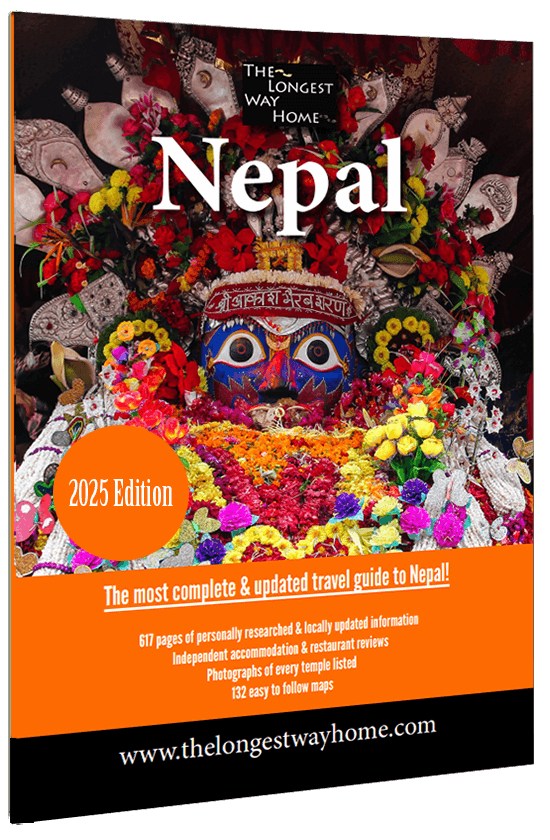 | 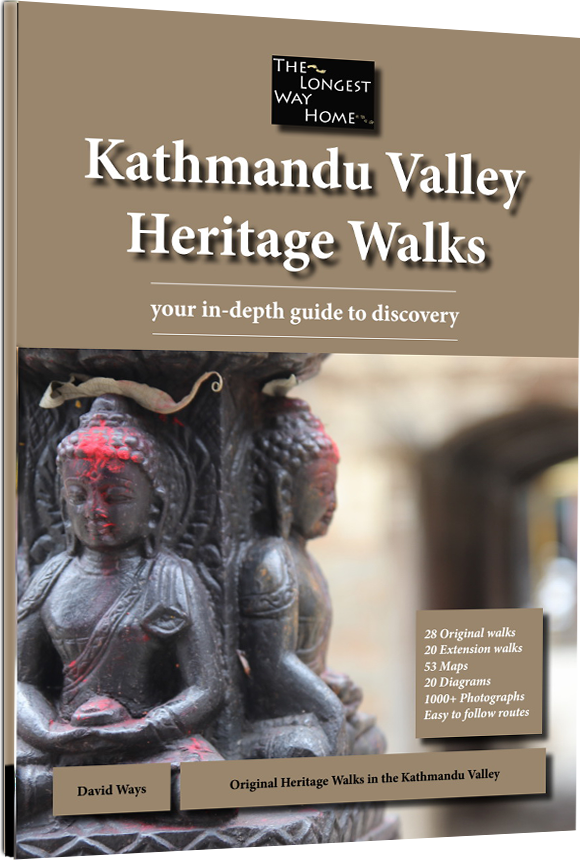 |
| Full Nepal Guidebook Complete country guide with quick heritage walks | Kathmandu Valley Heritage Walks Dedicated book for in-depth Heritage Walks in the Kathmandu Valley |
Or order both books together and get 50% off one!
Print versions also available.

Very impressive guide and tour of Bhaktapur! Well done.
Thank you Anna!
Amazing. This is a better guide than and guidebook we’ve read.
Haha. I hope it wasn’t my guidebook – it’s got a lot more in it that this page.
Again, very impressed with your work here. Your website and guides have really helped us a lot in planning our trip to Nepal.
Thanks. Glad you were able to plan your trip!
Like the others have said, this has been my number one source for up to date information on going to Nepal.
I’d like to mention that we emailed Nepal tourism with some questions and never heard make. Found the answers on your website though Dave. Bought your guide book and were blown away with how good it is. Thank you!
Thank you your kind words. Sorry to hear Nepal Tourism Board never replied to you – one more reason I wrote the book! Feel free to send me an email if you need anything not covered in it.
Fantastic write up and guide. We’ll use it and your book!
Thank you Mike
Discovered your site and it’s been our lead into traveling Nepal. We bought your guide book too and can easily say it’s heads above all the others.
Great to know this and thanks for the kind words!
Just completed this walk using this guide. Really enjoyed it. Taking a rest at peacock restaurant overlooking Dattatraya Square.
Totally agree about the tour guides here. Too aggressive for my liking.
Getting your book is my best option. Wish I discovered it before arriving here!
Nicely Explained. Thanks a lot for sharing it
You’re welcome